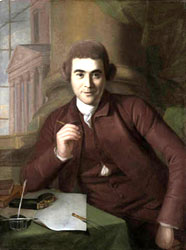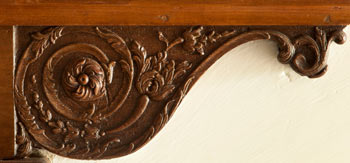Architect & Master Carver
Architect: William Buckland
 Under the supervision of George Mason, William Buckland produced the designs for the elaborate interiors of Gunston Hall. Born in 1734 in Oxford, England, Buckland moved to London in 1748 to begin his apprenticeship as a joiner/carpenter. Through his brother Thomson, George Mason indentured Buckland for the completion of his property in colonial Virginia. Upon arriving, with the shell of the exterior likely completed, Buckland focused his attentions on the interior of the mansion. The completed interiors represented the English Rococo in its full spectrum. The "Gothik," the "French Modern," the "Chinese," the Palladian and the Classical were all represented within the walls of Gunston Hall. An extraordinary building when it was built it remains so today. After his indenture ended, Buckland continued to work in the area. In 1760, he completed the new "Glebe House" for Truro Parish, located near Gunston Hall. He produced the interiors for Colonial Tayloe's Mount Airy from 1761 to 1764, which unfortunately were lost to fire in 1844. He also produced a bookcase, chimneypiece and a plan for Robert Wormeley Carter's (1766) house and worked on Landon Carter's Sabine Hall (1766). Also, he drew a house plan (1767) for Alexander Henderson in Colchester. Buckland worked on a number of public buildings during his career including the Richmond County Prison (1763) and the Richmond County workhouse (1767). His move to Annapolis, Maryland in 1771 led to two important commissions, the Chase-Lloyd House (1771) and the Hammond House (1774). Sadly, Buckland died at the age of forty in 1774 unable to see the completion of his last project. The first house he worked on, Gunston Hall, serves as a reminder of where William Buckland began and the importance of English design to society of colonial Virginia planters.
Under the supervision of George Mason, William Buckland produced the designs for the elaborate interiors of Gunston Hall. Born in 1734 in Oxford, England, Buckland moved to London in 1748 to begin his apprenticeship as a joiner/carpenter. Through his brother Thomson, George Mason indentured Buckland for the completion of his property in colonial Virginia. Upon arriving, with the shell of the exterior likely completed, Buckland focused his attentions on the interior of the mansion. The completed interiors represented the English Rococo in its full spectrum. The "Gothik," the "French Modern," the "Chinese," the Palladian and the Classical were all represented within the walls of Gunston Hall. An extraordinary building when it was built it remains so today. After his indenture ended, Buckland continued to work in the area. In 1760, he completed the new "Glebe House" for Truro Parish, located near Gunston Hall. He produced the interiors for Colonial Tayloe's Mount Airy from 1761 to 1764, which unfortunately were lost to fire in 1844. He also produced a bookcase, chimneypiece and a plan for Robert Wormeley Carter's (1766) house and worked on Landon Carter's Sabine Hall (1766). Also, he drew a house plan (1767) for Alexander Henderson in Colchester. Buckland worked on a number of public buildings during his career including the Richmond County Prison (1763) and the Richmond County workhouse (1767). His move to Annapolis, Maryland in 1771 led to two important commissions, the Chase-Lloyd House (1771) and the Hammond House (1774). Sadly, Buckland died at the age of forty in 1774 unable to see the completion of his last project. The first house he worked on, Gunston Hall, serves as a reminder of where William Buckland began and the importance of English design to society of colonial Virginia planters.
Master Carver: William Bernard Sears
 Not enough is known about William Bernard Sears considering his importance as an English carver working in the Virginia area. Born in London, Sears's exact age is uncertain. According to his son's recollections, George Mason indentured Sears to work on Gunston Hall. Sears worked as the master carver charged with translating William Buckland's designs into wood. The bond between the two men was undoubtedly strong because they continued working together after completing Gunston Hall. Sears worked with Buckland on the interiors of Mount Airy in 1761. With Buckland's move to Annapolis, their collaboration appears to have ended with Sears remaining in the Alexandria area. A notation in 1772 for a purchase of carving and gilding tools acknowledges his abilities to do expensive finishes in addition to carving. That same year he worked on two churches including Pohick Church. Sears also worked at Mount Vernon, completing the chimney piece in the small dinning room in 1775 with Going Lanphire. In 1777, Sears entered public service after being appointed Deputy Sheriff of Loudoun County until 1781. It appears that he stopped working as a master carver about this time. He died in 1818 and is buried in Alexandria.
Not enough is known about William Bernard Sears considering his importance as an English carver working in the Virginia area. Born in London, Sears's exact age is uncertain. According to his son's recollections, George Mason indentured Sears to work on Gunston Hall. Sears worked as the master carver charged with translating William Buckland's designs into wood. The bond between the two men was undoubtedly strong because they continued working together after completing Gunston Hall. Sears worked with Buckland on the interiors of Mount Airy in 1761. With Buckland's move to Annapolis, their collaboration appears to have ended with Sears remaining in the Alexandria area. A notation in 1772 for a purchase of carving and gilding tools acknowledges his abilities to do expensive finishes in addition to carving. That same year he worked on two churches including Pohick Church. Sears also worked at Mount Vernon, completing the chimney piece in the small dinning room in 1775 with Going Lanphire. In 1777, Sears entered public service after being appointed Deputy Sheriff of Loudoun County until 1781. It appears that he stopped working as a master carver about this time. He died in 1818 and is buried in Alexandria.
 Mansion
Mansion